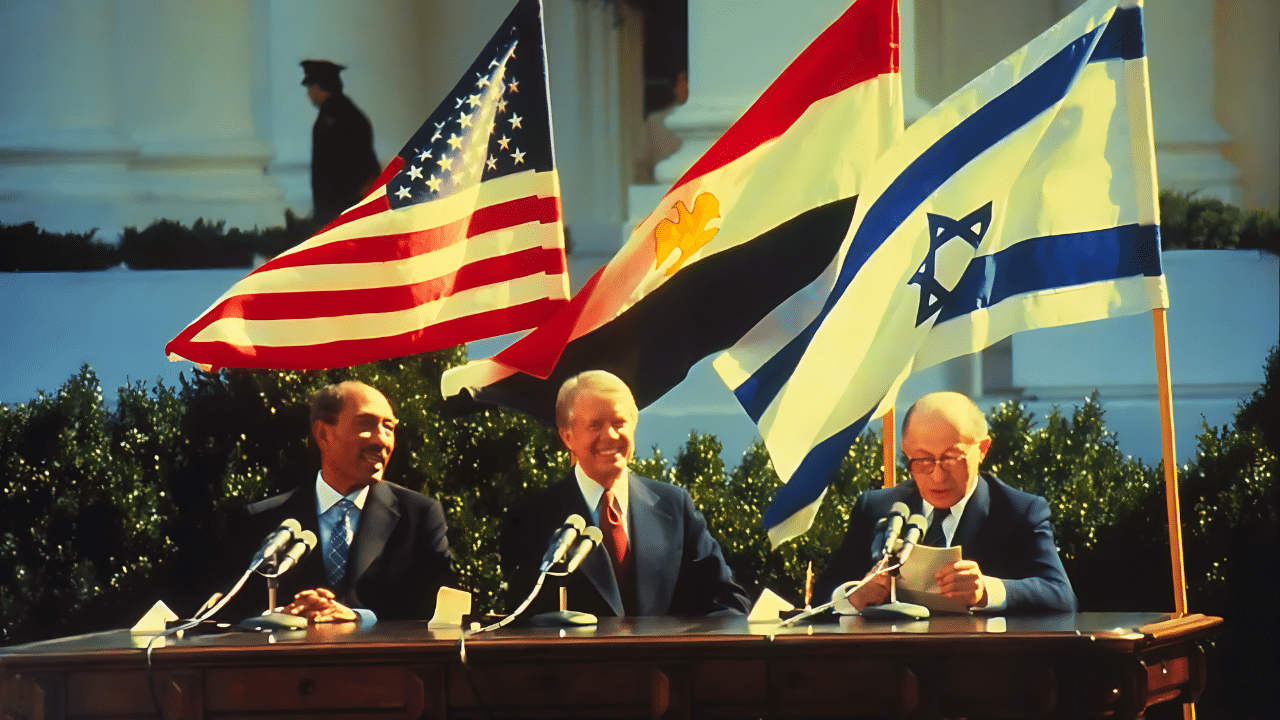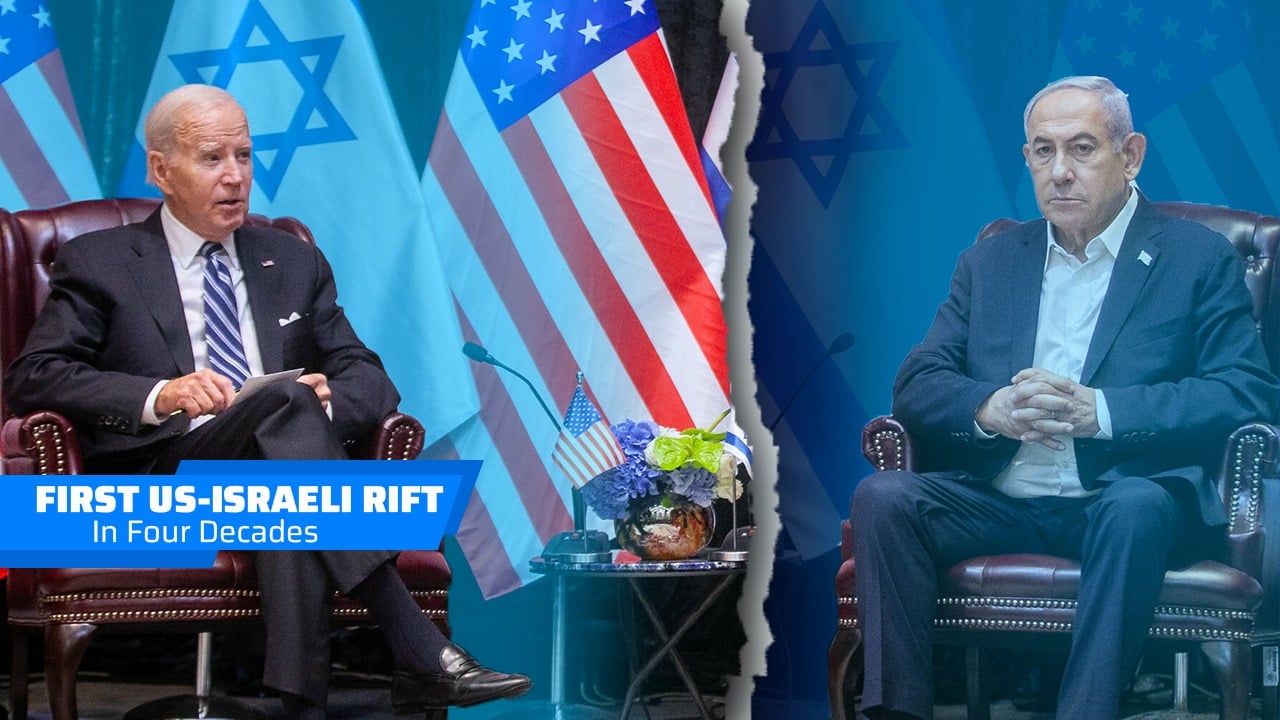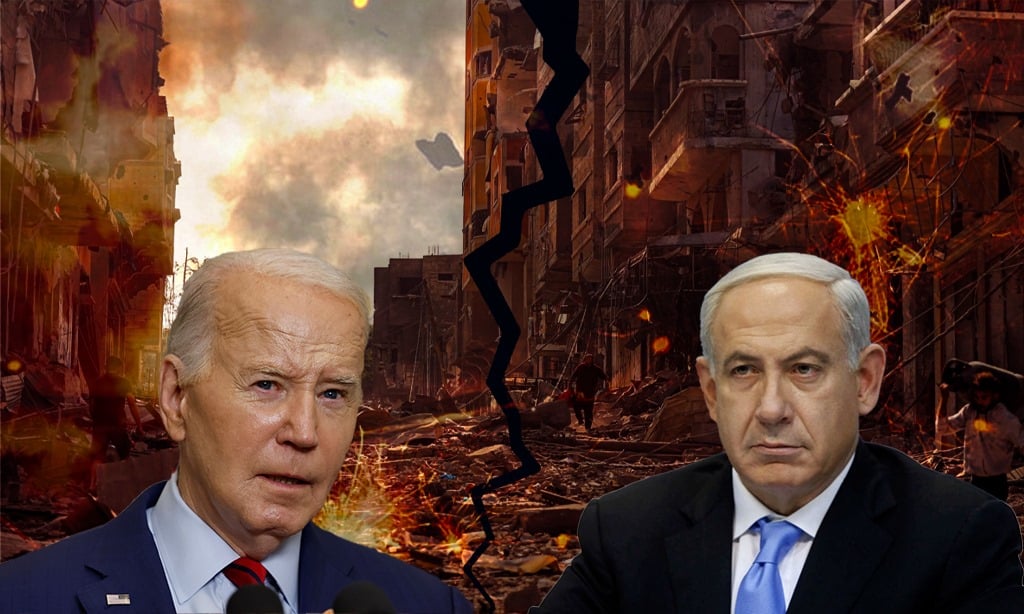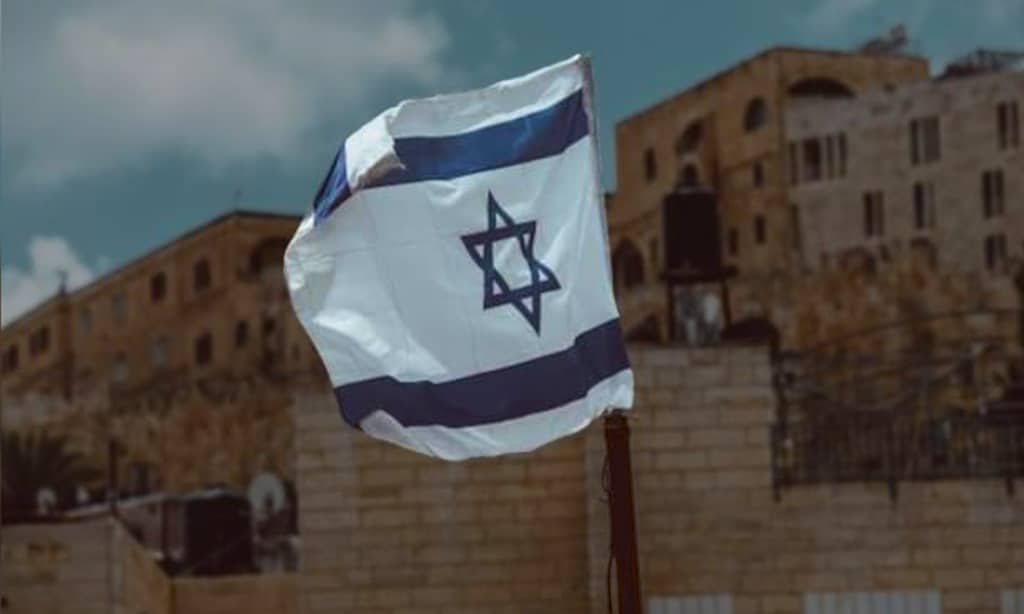Understanding the ups and downs of friendships can be tricky, especially when that friendship involves two countries like the United States and Israel. Imagine your two best friends suddenly not getting along after years of being close—confusing, right? That’s a bit like what’s happening now between these two nations.
Since 1948, when President Harry Truman first recognized Israel as a country, the United States has been one of its biggest supporters. Yet, recently, something unusual happened for the first time in forty years; President Joe Biden decided to stop an arms shipment to Israel.
This move has raised many eyebrows and left people wondering why, after so many years of friendship, things are starting to change.
This article will walk you through this rare rift between the US and Israel. It will explain what led up to Biden’s decision and what it means for both countries moving forward. No need to worry about big words or complicated ideas; we’ll keep it simple.
Ready to learn more? Let’s go!
TL;DR
The U.S. and Israel, longtime allies, are experiencing rare tensions over the conflict in Gaza. President Biden stopped an arms shipment to Israel, marking the first such move in 40 years. The two countries disagree on how to handle Hamas, with Biden cautioning Israel against excessive force while Israel argues tough measures are needed for security.
Within Israel, officials are divided on dealing with Hamas and potential U.S. sanctions. The rift is impacting Palestinian civilians, disrupting education in Gaza and coinciding with settler violence in the West Bank. Protests have erupted.
Looking ahead, the future of U.S.-Israel relations is uncertain. Finding common ground will be key. The situation at the Rafah border crossing could have major implications for Gaza. This moment may present an opportunity for both countries to reflect and potentially find new paths forward.
Historical Overview of US-Israel Relations
The friendship between the U.S. and Israel has lasted for many years, starting when the U.S. quickly recognized Israel in 1948. Over time, this bond faced tests through wars, peace treaties, and political agreements.
The 1948 Recognition
President Harry Truman quickly acknowledged Israel in 1948. This move marked a new chapter for U.S.-Israel ties. Right after Israel declared itself an independent nation, the U.S. showed its support.
This was a big step, showing the world where America stood.
This decision didn’t just happen out of nowhere. It followed years of tension and hope in the region. Many people around the world were watching closely. They wanted to see how countries would react to Israel’s announcement.
The U.S.’s fast recognition sent a strong message.
Back then, communication and politics worked differently than they do today. Yet, this action by President Truman has shaped relations between the two nations for decades since 1948; it laid a foundation that has lasted through many ups and downs in global politics.
The 1967 War
In 1967, the US stood by Israel during a critical conflict called the Arab-Israeli war. This support marked a significant moment in the relationship between the two countries. Tensions flared following an incident with the USS Liberty, which brought moments of strain.
This six-day fight saw Israel up against neighboring states, including Egypt and Jordan. The outcome significantly altered maps and future politics in the region. Despite these challenges, US-Israel ties remained strong, showcasing resilience even amid adversity.
The 1979 Peace Treaty

President Jimmy Carter worked hard to bring peace between Israel and its neighbors in 1979. This effort led to a historic agreement. Israel and Egypt signed the peace treaty after long talks.
The deal was important because it made Egypt the first Arab country to officially recognize Israel.
The treaty also required Israel to withdraw from areas it had taken, including the Sinai Peninsula. In return, Egypt agreed not only to recognize Israel but also to open up trade and diplomatic relations with them.
This step towards peace showed that even nations with deep differences could find ways to live side by side.
The 1993 Oslo Accord
In 1993, a big step towards peace was taken. Bill Clinton brought together Yitzhak Rabin and Yasser Arafat. They shook hands at the White House. This handshake was part of the Oslo Accord.
The accord aimed to create peace between Israel and Palestine.
The agreement set rules for how parts of the West Bank and Gaza Strip would be governed. It allowed for self-rule in some areas by Palestinians. Yet, not all issues were solved, leading to more talks in the future.
The 2010 Settlement Dispute
The 2010 Settlement Dispute began with an issue that created tension between the United States and Israel. The heart of the matter was about building homes in areas many people around the world watched closely.
These places were not just any land—they were spots where history, politics, and the lives of everyday folks intersected.
Israel decided to build more houses in these contested spaces. This move upset a lot of people, including leaders in America. U.S. officials had been working hard on peace talks between Israelis and Palestinians.
They saw this step as turning back the clock on their efforts to bring peace to a region filled with too much conflict.
Discussion between President Obama’s team and Israeli leaders became intense. Both sides felt strongly about their stances on how to achieve peace and safety for everyone involved—whether living there now or hoping for a homeland they could call their own one day. Additionally, you can also read about the history of the Israel vs Palestine Conflict History.
The Deepening Rift: Biden and Netanyahu
Tensions grow between President Joe Biden and Prime Minister Benjamin Netanyahu over their different views on Gaza. This strain shows the changing landscape of U.S.-Israel ties, marking a new chapter in their long history.
Divergent Views on Gaza
Biden supports Israel in its fight against Hamas. Yet, he warns about using too much force in Gaza. This shows a clear split between the US and Israeli approaches to handling conflict in the region.
Biden even stopped an arms delivery because he was worried about how it could harm people’s rights.
Israel sees its actions as needed for security. They argue that tough measures are necessary to stop attacks from Hamas militants. The US, on the other hand, stresses caution and worries about the impact on civilians.
This difference has led to some tough conversations between American and Israeli leaders, showing that they don’t always see eye-to-eye on Gaza.
The Issue of Sanctions
The U.S. decided to put sanctions on the Israeli military group Netzah Yehuda. They did this because of human rights issues. The Leahy Law was the rule they used to follow. This law says the U.S. cannot give help to foreign military units that break human rights rules.
These sanctions made things tense between the U.S. and Israel. Both countries have been close friends for a long time, helping each other out in many ways, like with safety and information sharing about threats from groups who don’t like them, such as Hamas.
Now, these new rules are testing their relationship and making people watch closely how both sides will act next.
The “Different Red Lines”
Biden and Netanyahu do not agree on how to deal with Gaza. They each draw their lines in the sand differently. Biden criticizes Israel’s control over Gaza’s borders because it stops aid from reaching people who need it.
He thinks this approach is wrong.
Netanyahu, on the other hand, points fingers at Hamas. He says they mess with efforts to help Palestinians by either blocking or taking the resources meant for civilians. This blame game shows a clear divide in how each leader sees the path to peace and safety in the region.
These disagreements mark a new phase of tension between the U.S. and Israel. Such differences have not been this sharp in over 40 years. Both leaders stand firm, making it hard to find common ground on Gaza’s future and its people’s well-being.
Rifts Among Israeli Officials
In Israel, leaders argue about how to fight Hamas. They also can’t agree on how to deal with possible U.S. sanctions.
Handling the War Against Hamas
Israeli officials face tough decisions in the war against Hamas. They balance attacking targets with protecting civilians. The challenge lies in hitting militant sites without harming nearby residents.
This requires precise intelligence and careful planning. Often, they use drones for surveillance before taking any action.
Israel’s strategy also involves responding to global concerns about civilian harm. They try to justify their actions by showing evidence of Hamas using civilians as shields. This includes storing weapons in schools or launching attacks from populated areas.
Israel aims to weaken Hamas’ grip while avoiding international backlash over civilian casualties.
Israel’s Response to Expected U.S. Sanctions
Israel plans to stand firm against the U.S. sanctions that may come its way. Leaders have made statements suggesting they won’t back down easily. They believe in defending their actions and policies, even if it means facing financial or diplomatic consequences from the United States.
Officials are preparing arguments to counter these expected sanctions, focusing on their right to defend themselves. They aim to persuade international allies and organizations of their stance through diplomacy.
The idea is not just to avoid penalties but also keep strong relationships with other countries during this challenging time.
Implications on the Ground
The rift affects people and places deeply. It touches lives, from schools in Gaza to streets in the West Bank.
Impact on Gazans and their Education System
War has hit Gazans hard, especially students. Many schools lie in ruins. With bombs falling, learning has stopped. Kids cannot go to school safely. They miss lessons and fall behind.
Teachers are trying their best under tough conditions. They hold classes where they can — sometimes even outdoors or in damaged buildings. But it’s not enough. Without proper classrooms or materials, education suffers.
Students feel the loss deeply. Dreams of becoming doctors, teachers, or engineers fade away with each passing day of conflict. For Gazans young and old, rebuilding life and restoring hope for a better future remains a challenge amidst ongoing unrest.
Israeli Settler Violence in the West Bank
Israeli settlers in the West Bank have attacked Palestinians. These actions hurt people and their homes. Groups like Yesh Din report these incidents. They show a big problem that needs fixing.
This violence makes life hard for Palestinians. It damages their buildings, land, and safety. People around the world are watching and want it to stop.
Protests in Gaza
People in Gaza are standing up, voicing their anger against Israel’s actions. These protests show the deep frustrations of Gazans. Their cries for peace and justice fill the streets, pushing back against what they see as aggression.
Around the world, from big cities to small towns, many join in solidarity with Gaza’s protesters. They hold rallies and make signs calling for an end to the conflict. The message is clear: people everywhere want peace and fairness in this long-standing dispute.
The Future of US-Israel Relations

The future of ties between the US and Israel looks to face tests, with room for both strife and hope as they move ahead.
Strains and the Way Forward
The recent strains between the US and Israel have raised many eyebrows around the world. BBC journalist Tom Bateman discussed how President Joe Biden’s decisions affect these ties.
Both nations have shown different stances on critical issues such as Gaza, sanctions, and their red lines, which mark points of no return. These differences are not just in policy but also in how each views the path to peace and security in a region filled with turmoil.
Israel faces its own internal rifts, especially among officials on handling conflict with Hamas and responding to possible US sanctions. This discord shows a complex political landscape within Israel itself.
Meanwhile, Gazans suffer from an education system under siege by conflict, while settler violence in the West Bank continues unabated. Protests in Gaza highlight the humanitarian crisis that deepens with every passing day.
Moving forward requires both countries to find common ground, despite their differences. The situation at Rafah and potential impacts hint at broader regional implications if tensions don’t ease.
A focus on humanitarian aid could bridge gaps, supporting Gazans without fueling further conflict. Dialogue remains crucial – open channels between US President Joe Biden’s administration and Israeli Prime Minister Benjamin Netanyahu could lead to shared solutions for peace.
Potential Impact of the Rafah Situation
The situation at Rafah could lead to big changes in Gaza. If the border stays closed, many people might not have enough food. There are already over half a million people in Gaza who could face hunger.
This issue is very serious.
Keeping Rafah open is also important for getting supplies into Gaza. Things like medicine, food, and fuel need to come through this crossing. If it’s blocked, Gaza will face more challenges.
Peace talks and efforts to help those living there might be harder to carry out.
Takeaways
This rift between the US and Israel is a big deal. It shows us how friends can disagree on important issues. Let’s hear from an expert, Dr. Samuel Levine, who knows a lot about this topic.
Dr. Levine has studied international relations for years. He teaches at a big university and writes books about peace processes and global politics. His work helps people understand tough situations like this one.
Dr. Levine says that disagreements between long-time allies are common in history. This particular disagreement might actually help both countries think more about their actions and choices.
He talks about safety and ethics too. According to him, all countries should follow rules that keep people safe during conflicts. Dr. Levine believes that being clear about why decisions are made is very important for trust.
For everyday life, he suggests staying informed through reliable news sources can help you understand better what’s happening around the world.
In his final words, Dr. Levine gives his opinion. This moment could be a chance for change. It might lead to new ways of solving problems if everyone learns from it. So, this rift isn’t just bad news. It could help us find better paths forward if we’re willing to learn










































